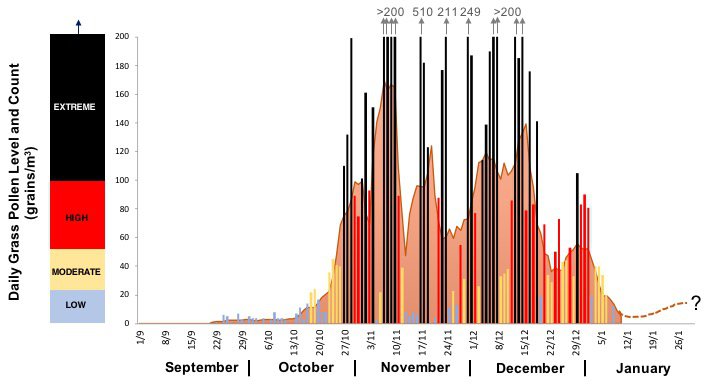A January update - relief for those with grass pollen allergy in sight
Jan. 9, 2022
Now the new year is here and 2022 has introduced itself to Canberrans - in albeit a fairly brusk way - its time for a quick update on the airborne pollen situation.
The record grass pollen season of spring-summer 2021 has been the bane of hay fever sufferers in Canberra and the regions. The high and persistent rainfall alongside warm temperatures has been the perfect combination to produce abundant grass growth, and along with it, abundant pollen production. Normally, the grass pollen season is over by mid-late December, but this year we predicted a longer and stronger season than we have ever experience before.
Where are we up to in the grass pollen season for 2021-22?
We continue to monitor the daily pollen count over the summer break and Figure 1 below shows the latest grass pollen count from the 1st September to the 9th January 2022. The addition of a 7-day moving average of the daily pollen count demonstrates a clear decline in grass pollen daily counts since the last EXTREME grass pollen day on the 30th December 2021. This is a very positive sign for all those who suffer from hay fever or asthma as the trend is definitely towards more MODERATE to LOW pollen days - a trend that means less wheezing and sneezing!

Figure 1. Daily grass pollen counts and moving 7-day average for Canberra from 1st September to the 9th January 2022. The filled (orange) curve is the 7-day moving average for the daily pollen count. The histogram shows daily counts colour coded to match the accepted pollen levels reported by CanberraPollen.com.au. EXTREME days are when the airborne grass pollen concentration is 100 or more pollen grains and these days are the worst for hay fever and asthma sufferers.
Will this trend continue throughout January 2022?
Grass pollen production will be difficult to predict during January as we are aware of a secondary peak pollen period for grasses that has occurred from mid-late January. This is due to the flowering of subtropical grasses such as Bermuda Grass and Buffalo Grass that are present in the Canberra region and may well produce abundant pollen in the coming weeks.
Keep watching our forecast and tweets from CanberraPollen and AirRater over the next few weeks and make sure you are up to date on the daily pollen count and latest trends in our data. For more information refer to
CanberraPollen.com.au
AirRater.org.au


